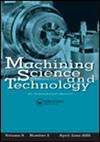On grinding force ratio, specific energy, G-ratio and residual stress in SQCL assisted grinding using aerosol of MWCNT nanofluid
IF 2.6
4区 工程技术
Q2 ENGINEERING, MANUFACTURING
引用次数: 16
Abstract
Abstract In the present investigation, water based multi-walled carbon nanotube (MWCNT) dispersed nanofluid was produced and used as a cutting fluid in small quantity cooling lubrication (SQCL) assisted grinding of hardened AISI52100 steel. The work material was ground by an alumina wheel. The SQCL technology utilizes atomized aerosol of liquid grinding fluid. Use of MWCNT nanofluid aerosol in place of soluble oil was found to be substantially beneficial in reduction of specific energy and development of compressive residual stress on ground surface. The steady and lower value of the force ratio (tangential to normal grinding force, Ft/Fn) was suggestive of the superior lubrication and grit sharpness retention ability of the aerosol of MWCNT nanofluid. Higher compressive residual stress on the ground surface under MWCNT nanofluid environment suggests lesser grinding zone temperature, which can be attributed to its superior wettability, lubricity and heat dissipation ability of the MWCNT nanofluid. The consumption rate of grinding fluid in SQCL was varied. It could be reduced to 200 ml/h for MWCNT nanofluid to obtain an almost similar or better effect to that of 500 ml/h for soluble oil. Lesser surface tension of MWCNT nanofluid, compared to its counterpart, seemed to facilitate wetting, thus improving lubrication and heat transfer capability further.MWCNT纳米流体气溶胶辅助磨削的磨削力比、比能、g比和残余应力研究
制备了水基多壁碳纳米管(MWCNT)分散纳米流体,并将其作为切削液用于少量冷却润滑辅助磨削淬硬AISI52100钢。工作材料是用氧化铝砂轮研磨的。SQCL技术利用液体研磨液的雾化气溶胶。研究发现,使用纳米碳纳米管纳米流体气溶胶代替可溶性油,在降低比能和发展地面压缩残余应力方面有很大的好处。力比(切向与法向磨削力,Ft/Fn)的稳定和较低的值表明MWCNT纳米流体气溶胶具有良好的润滑和磨粒锐度保持能力。MWCNT纳米流体环境下,磨削区温度较低,地表压缩残余应力较高,这是由于MWCNT纳米流体具有较好的润湿性、润滑性和散热性。在SQCL中,研磨液的消耗率是不同的。MWCNT纳米流体可以减少到200 ml/h,以获得与可溶性油500 ml/h几乎相同或更好的效果。MWCNT纳米流体的表面张力较低,与之相比,似乎有利于润湿,从而进一步提高润滑和传热能力。
本文章由计算机程序翻译,如有差异,请以英文原文为准。
求助全文
约1分钟内获得全文
求助全文
来源期刊

Machining Science and Technology
工程技术-材料科学:综合
CiteScore
5.70
自引率
3.70%
发文量
18
审稿时长
6 months
期刊介绍:
Machining Science and Technology publishes original scientific and technical papers and review articles on topics related to traditional and nontraditional machining processes performed on all materials—metals and advanced alloys, polymers, ceramics, composites, and biomaterials.
Topics covered include:
-machining performance of all materials, including lightweight materials-
coated and special cutting tools: design and machining performance evaluation-
predictive models for machining performance and optimization, including machining dynamics-
measurement and analysis of machined surfaces-
sustainable machining: dry, near-dry, or Minimum Quantity Lubrication (MQL) and cryogenic machining processes
precision and micro/nano machining-
design and implementation of in-process sensors for monitoring and control of machining performance-
surface integrity in machining processes, including detection and characterization of machining damage-
new and advanced abrasive machining processes: design and performance analysis-
cutting fluids and special coolants/lubricants-
nontraditional and hybrid machining processes, including EDM, ECM, laser and plasma-assisted machining, waterjet and abrasive waterjet machining
 求助内容:
求助内容: 应助结果提醒方式:
应助结果提醒方式:


